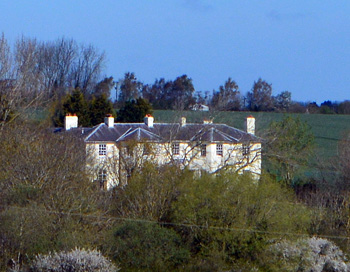Park House Toddington
![Toddington Park about 1905 [Z1306/126]](/CommunityHistories/Toddington/ToddingtonImages/Toddington Park about 1905 [Z1306-126]_350x225.jpg)
Toddington Park about 1905 [Z1306/126]
Park House was listed in 1980 by the former Department of the Environment as Grade II, of special interest. Built in the early 19th century with later 19th century alterations and additions its features include colour-washed stucco, a hipped slate roof with an eaves cornice, a first floor band and two canted bays.
Park House was built in 1824 by the Cooper family as a replacement for the old Manor House, which was leased during the earlier part of the 19th century. By 1851 members of the family were living at both Toddington Manor and Park House, with Elizabeth and William Dodge Cooper Cooper at the Manor House and their son William Cooper Cooper at the newer property. By the 1890s Park House had become known as Toddington Park, or simply The Park. Alterations were made to the house in 1896, but soon after this William Smith Cowper Cooper moved to the Manor House to live with his elderly father. Park House was let to Robert Standish Sievier, an inveterate gambler and hunting enthusiast. Sievier had a cricket pitch laid out at which an M.C.C. team led by no less than W.G. Grace played against a Bob Sievier XI. After Sievier's short but long-remembered stay in Toddington William Smith Cowper Cooper's daughter, Lady Edith Vernon moved into The Park, but she also moved on to the Manor House after her father's death in 1905. In 1907 The Park was sold to Colonel Mercer, a former High Sheriff of Bedfordshire. When he died in 1921 The Park was again sold, this time to Charles Ireland, a Toddington man who had made money through property dealing.
The Rating and Valuation Act 1925 specified that every building and piece of land in the country was to be assessed to determine its rateable value. The valuation book compiled at this time shows that Toddington Park was owned and occupied by Charles Ireland [DV1/C82/1]. The house provided the following accommodation:
- Downstairs: Kitchen, 12½ feet by 18 feet (facing south-west and dark); pantry; scullery; housekeeper's room, 16 feet by 16 feet; larder (all these rooms making up the domestic offices were described as "bad"); cellars; drawing room 30 feet by 20½ feet, 9½ feet by 7½ feet, 15 feet by 9feet (formerly billiard room), the "only decent room in the house"; study 14½ feet by 17½ feet; dining room 12 feet by 15 feet, 13½ feet by 19 feet.
- Upstairs: Dressing room; five bedrooms sized 15 feet by 12½ feet, 20 feet by 17 feet, 15½ feet by 13 feet, 18 feet by 14½ feet, 12 feet by 13 feet; four maids' rooms (also "bad"); bathroom; storeroom; WC.
- Outside: Brick and slate stables for 2, fodder house, harness room, coach house, garage, mess room; thatched coach house and stores; brick and slate stable and loft; timber laundry; brick and tile model dairy; four greenhouses; five acres of grounds ("very poor").
Water was provided from a pump on the estate. There was septic tank drainage, central heating with eight radiators, but no electric light. The valuer commented that nothing had been spent on the house since Robert Standish Sievier left in 1901, that there was only one bathroom and a passage instead of a hall, that the maids' arrangements were very bad and the drive up to the house awful.
In 1930 Charles Ireland was made bankrupt and during the Second World War. The Park became a base for the Women's Land Army from 1941 [WW2/AC/2/8]. In 1962 it was purchased by Sir Neville Bowman-Shaw, the owner of Lancer Boss, a company producing forklift trucks in Leighton Buzzard, who like the Coopers before him also later moved on to Toddington Manor. In 2012 plans were submitted to turn Toddington Park House into a hotel and spa.

Toddington Park from Park Road April 2016